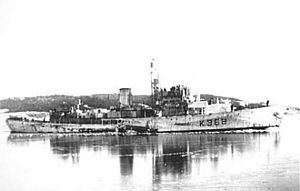Name HMCS Trentonian Ordered April 1942 Commissioned 1 December 1943 Construction started 19 February 1943 Draft 3.4 m | Laid down 19 February 1943 Decommissioned 22 February 1945 Launched 1 September 1943 | |
 | ||
HMCS Trentonian was a modified Flower-class corvette that served with the Royal Canadian Navy during the Second World War. She fought primarily in the Battle of the Atlantic and the English Channel as a convoy escort. She was named for Trenton, Ontario, though due to a naming conflict with another vessel, her name was changed. She was sunk in 1945.
Contents
Background
Flower-class corvettes like Trentonian serving with the Royal Canadian Navy during the Second World War were different from earlier and more traditional sail-driven corvettes. The "corvette" designation was created by the French as a class of small warships; the Royal Navy borrowed the term for a period but discontinued its use in 1877. During the hurried preparations for war in the late 1930s, Winston Churchill reactivated the corvette class, needing a name for smaller ships used in an escort capacity, in this case based on a whaling ship design. The generic name "flower" was used to designate the class of these ships, which – in the Royal Navy – were named after flowering plants.
Corvettes commissioned by the Royal Canadian Navy during the Second World War were named after communities for the most part, to better represent the people who took part in building them. This idea was put forth by Admiral Percy W. Nelles. Sponsors were commonly associated with the community for which the ship was named. Royal Navy corvettes were designed as open sea escorts, while Canadian corvettes were developed for coastal auxiliary roles which was exemplified by their minesweeping gear. Eventually the Canadian corvettes would be modified to allow them to perform better on the open seas.
Construction
Trentonian was ordered April 1942 as part of the 1942–43 modified Flower-class building programme. This programme was known as the Increased Endurance. Many changes were made, all from lessons that had been learned in previous versions of the Flower class. The bridge was made a full deck higher and built to naval standards instead of the more civilian-like bridges of previous versions. The platform for the 4-inch main gun was raised to minimize the amount of spray over it and to provide a better field of fire. It was also connected to the wheelhouse by a wide platform that was now the base for the Hedgehog anti-submarine mortar that this version was armed with. Along with the new Hedgehog, this version got the new QF 4-inch Mk XIX main gun, which was semi-automatic, used fixed ammunition and had the ability to elevate higher giving it an anti-aircraft ability.
Other superficial changes to this version include an upright funnel and pressurized boiler rooms which eliminated the need for hooded ventilators around the base of the funnel. This changes the silhouette of the corvette and made it more difficult for submariners to tell which way the corvette was laying.
Trentonian was laid down by Kingston Shipbuilding Co. at Kingston, Ontario 19 February 1943 and was launched 1 September later that year. She was commissioned into the Royal Canadian Navy 1 December 1943 at Kingston.
Service history
After working up, Trentonian was assigned to Western Approaches Command in March 1944 in preparation for duties in association with Operation Neptune, the naval component of the Allied invasion of Normandy. During the invasion she was escorting the cable ship St. Margaret on 13 June when an American destroyer mistakenly began firing at her. Trentonian suffered some damage when a shell, which was a dud, penetrated the outer hull and passed through the ship.
Sinking
In late August 1944 Trentonian transferred to Plymouth Command and was made part of escort group EG 41. While with this unit her primary duties were escorting Channel convoys. On 22 February 1945, while escorting a Channel convoy she was torpedoed by U-1004 near Falmouth. There were six casualties.
